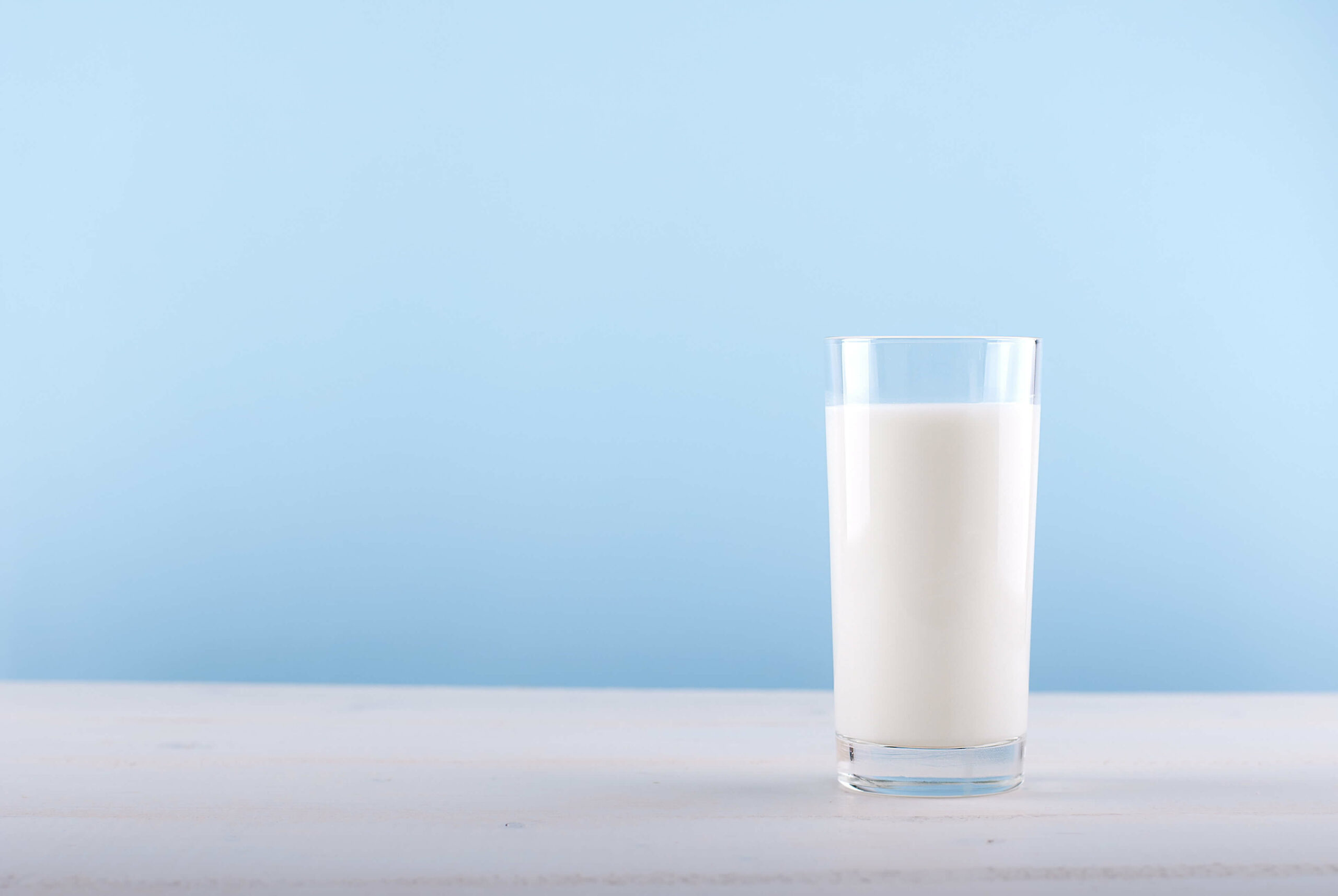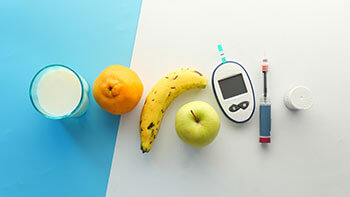Holistic Health Benefits of the Milk Matrix: Beyond Individual Nutrients For many years, nutrition research focused on how individual nutrients,..
GET THE FACTSMilk and Lactose Intolerance
Having lactose intolerance does not mean your patients need to give up dairy
Highlights:
- Evidence shows many people can still enjoy dairy foods such as milk, cheese and yogurt, even if they have lactose intolerance.
- Limiting the intake of dairy foods due to lactose intolerance means needlessly missing out on the health benefits of dairy.
- People diagnosed with lactose intolerance can tolerate some lactose. Rather than cutting all dairy, patients can adjust lactose intake according to tolerance.
Some people have trouble digesting lactose, but that doesn’t mean giving up dairy! Read on to learn more about lactose intolerance, how it’s formally diagnosed, and how you can provide the best nutrition advice to patients.
What is lactose?
Lactose is a type of naturally occurring sugar found in milk. It is produced by mammary glands of animals, so their resulting milk contains lactose. Cow’s milk naturally contains about 5 percent lactose1.
Fermented cow’s milk in yogurt has less lactose than in fluid milk because of the conversion of lactose by lactic acid bacteria. Hard cheeses contain very low levels or no lactose, while soft cheese may have more lactose depending on the production process2.
What is lactose intolerance?
Lactose intolerance is the inability to digest lactose, a natural occurring sugar found in milk and other dairy products. Humans require lactase enzyme to break down lactose3. When this enzyme is in short supply, lactose isn’t broken down and gets fermented by the gut microbiota, which leads to symptoms such as:
- Diarrhea
- Abdominal pain
- Cramps
- Bloating
- Flatulence4
These symptoms usually begin about 30 minutes to two hours after consuming milk if you are lactose intolerant5.
Lactose intolerance vs. milk allergy
Lactose intolerance is often confused with a milk allergy, but the two are different. Lactose intolerance affects the digestive system and is a gastrointestinal reaction to lactose; it does not elicit an immune response. A milk allergy is an immune-mediated reaction to the protein in milk.
Symptoms of milk allergy may include gas, cramps, and diarrhea (which is why it’s often confused with lactose intolerance) but may also include traditional allergy symptoms such as hives or wheezing6.
Types of lactose intolerance
There are three distinct types of lactose intolerance7:
- Primary lactose intolerance: The most common form; the result of low levels of lactase enzyme. It’s usually diagnosed in teen or early adult years.
- Secondary lactase deficiency: A transient condition that comes after suffering intestinal damage from an infection, antibiotic use, celiac disease, Crohn’s disease, etc. It can happen at any age.
- Congenital lactase deficiency: An extremely rare condition that starts at birth. Only 40 cases have been reported to-date globally.
Who gets lactose intolerance?
Lactase activity is high at birth since breast milk contains lactose. Tolerance progressively declines after weaning, and some can digest more lactose than others. The ability to digest lactose is common in populations that raise cattle and consume more dairy foods, as well as their descendants8.
Lactose intolerance likely started due to a genetic mutation in the LTC gene, which is responsible for making lactase enzymes9. This condition is most common in people from East Asian, African and South American descent. It’s least common in people from Northern European descent10.
How is lactose intolerance diagnosed?
Patients who have gas or cramps after they drink milk may think they have lactose intolerance and may erroneously self-diagnose. This is potentially harmful since they may cut out milk unnecessarily before a definitive diagnosis.
The most accurate diagnosis comes from a non-invasive hydrogen breath test, though lactose intolerance can also be diagnosed by a blood test11. It’s important to obtain a true diagnosis, because symptoms such as gas, cramps and bloating may be part of many different digestive disorders. In fact, lactose intolerance is just one potential cause of digestive symptoms.
If it’s not lactose intolerance, what else could it be?
The symptoms of lactose intolerance can overlap with different digestive disorders, so it’s important to ensure patients are properly tested and diagnosed. Other conditions that may share symptoms with lactose intolerance include 12, 13:
- Milk allergy
- Other food allergies
- Celiac disease
- Irritable bowel syndrome and associated FODMAP triggers
- Colitis
- Crohn’s disease
- Excessive sugar intake
Managing lactose intolerance
Eliminating milk and other dairy products is not a necessary treatment for someone who is diagnosed with lactose intolerance14. This is a common misconception.
Several international health organizations and authorities such as the National Institute of Health, National Medical Association and the American Academy of Pediatrics Committee on Nutrition, recommend that individuals with lactose intolerance do not need eliminate milk and dairy products from their diet. 15, 16, 17
Lactose intolerance varies from mild to severe18. Some people with lactose intolerance can consume 12-24 grams of lactose daily if the amount is spread out over the day and consumed as part of mixed meals19. Most people can digest a cup of milk (about 12 g lactose) with no problem20. Here’s a chart that shows the amount of lactose in a variety of dairy products:
| Milk Product | Lactose Content (grams) |
| Cow milk, 2% M.F. 250 mL | 12.92 |
| Cottage cheese, 2% M.F. 125 mL | 4.62 |
| Yogurt, plain, 2-3.9% M.F. 125 mL | 3.25 |
| Cream cheese, 50 g | 1.60 |
| Cheddar cheese, 50 g | 0.12 |
| Parmesan cheese, 50 g | 0.08 |
| Mozzarella cheese, 50 g | 0.04 |
| Swiss cheese, 50 g | 0.03 |
Chart information from the Canadian Society of Intestinal Research
Why is cheese often low in lactose? Hard matured cheeses tend to have less lactose than soft cheese. This is because lactose is lost when whey is removed, and bacterial cultures are added during the cheese-making fermentation process. As the cheese ripens and matures, the lactose gets converted into lactic acid, which does not cause intolerance21.
Patients with lactose intolerance can manage their symptoms without cutting out milk entirely. They can test which of these methods works best for them – perhaps it’s a combination of these tips22:
- Use lactase enzyme supplements before ingesting foods that contain lactose. These supplements help break down lactose, making lactose-containing foods easier to digest23.
- Try dairy products that are low in lactose, such as hard cheese (see chart above).
- Use lactose-free dairy products. Choose milk, cheese and yogurts that are specifically labelled “lactose free.”
- Enjoy fermented dairy products such as yogurt, kefir and hard cheese. The fermentation process includes the use of bacteria that help break down lactose.
- Eat lactose-containing foods at meals alongside other foods. Digesting other foods at the same time slows gastric emptying, and lactose makes up a smaller percent of the total food being digested. Less lactase enzyme is needed to break down the lactose.
What is lactose free milk? Lactose-free milk is made by introducing lactase enzyme into milk. The lactase breaks down the natural occurring lactose in milk, allowing people with lactose intolerance to continue to enjoy milk.
Milk and health benefits
For patients with lactose intolerance, avoiding dairy isn’t the answer. Milk is a nourishing whole food and is source of 15 essential nutrients including protein, calcium, vitamin D and vitamin B12.
Many studies support the importance of milk, cheese and yogurt as part of a healthy eating pattern. In addition to dairy foods contributing to bone and dental health, studies have linked these foods to other health benefits including reduced risk of stroke, metabolic syndrome, hypertension, colon cancer, and type 2 diabetes. 24, 25, 26, 27, 28
Plus, lactose may act as a prebiotic in the digestive system and help enhance the microbiome. People with lactose intolerance who consume dairy can develop colonic adaptation by the microbiome due to the consistent presence of lactose. This process may mimic a prebiotic effect and help people with lactose intolerance develop an ability to tolerate lactose and consume more dairy foods.
CITATIONS
1Food and Agricultural Organization. Gateway to dairy production and products. https://www.fao.org/dairy-production-products/products/milk-composition/en/
2Gille, D. (2018). Detection of lactose in products with low lactose content. International Dairy Journal. 83, 17-19. https://www.sciencedirect.com/science/article/pii/S0958694618300608#:~:text=Lactose%20quantification%20in%20dairy%20products,after%20hydrolysis%20with%20%CE%B2%2Dgalactosidase
3Lactose Intolerance. Merck Manual 2023. https://www.merckmanuals.com/en-ca/home/digestive-disorders/malabsorption/lactose-intolerance
4Di Costanzo M, et al. (2018). Lactose Intolerance: Common Misunderstandings. Ann Nutr Metab. 73 Suppl 4:30-37. doi:10.1159/000493669
5Canadian Digestive Health Foundation. Managing Lactose Intolerance. https://cdhf.ca/en/managing-lactose-intolerance/
6Milk. Food Allergy Canada. https://foodallergycanada.ca/allergies/milk/
7Malik T. et al. (2023). Lactose Intolerance. https://www.ncbi.nlm.nih.gov/books/NBK532285/
8Heine RG, AlRefaee F, Bachina P, et al. Lactose intolerance and gastrointestinal cow’s milk allergy in infants and children –common misconceptions revisited. World Allergy Organ J. 2017; 10:41
9National Institutes of Health. Lactose intolerance. https://medlineplus.gov/genetics/condition/lactose-intolerance/#causes
10https://www.karger.com/Article/FullText/493669
11Merck Manual. Lactose Intolerance. https://www.merckmanuals.com/en-ca/home/digestive-disorders/malabsorption/lactose-intolerance#:~:text=Diagnosis%20of%20Lactose%20Intolerance&text=The%20hydrogen%20breath%20test%20(also,breath%20at%201%2Dhour%20intervals.
12Pal S, et al. (2015). Milk Intolerance, Beta-Casein and Lactose. Nutrients. 7(9):7285-7297. doi:10.3390/nu7095339
13International Foundation for Gastrointestinal Disorders. Lactose Intolerance. https://iffgd.org/gi-disorders/lactose-intolerance/
14Canadian Digestive Health Foundation. Lactose Intolerance. https://cdhf.ca/en/digestive-conditions/lactose-intolerance/
15Suchy FJ et al. (2010). NIH Consensus Development Conference Statement: lactose intolerance and health. NIH Consens State Sci Statements;27:1-27. https://pubmed.ncbi.nlm.nih.gov/20186234/
16Heyman MB. (20060. Lactose intolerance in infants, children and adolescents. Pediatrics. 118:1279-86. https://publications.aap.org/pediatrics/article/118/3/1279/69390/Lactose-Intolerance-in-Infants-Children-and?autologincheck=redirected
17Bailey RK et al. (2013). Lactose intolerance and health disparities among African Americans and Hispanic Americans: and updated consensus statement. J Natl Med Assoc 105:112-127. https://www.sciencedirect.com/science/article/abs/pii/S0027968415301139?via%3Dihub
18Di Costanzo M, et al. (2018). Lactose Intolerance: Common Misunderstandings. Ann Nutr Metab. 73 Suppl 4:30-37. doi:10.1159/000493669
19Forsgård RA. Lactose digestion in humans: intestinal lactase appears to be constitutive whereas the colonic microbiome is adaptable. Am J Clin Nutr. 2019;110(2):273-279. https://www.sciencedirect.com/science/article/pii/S0002916522011765?via%3Dihub
20Savaiano DA, Boushey CJ, McCabe GP. (2006). Lactose intolerance symptoms assessed by meta-analysis: a grain of truth that leads to exaggeration. J Nutr. 2006;136(4):1107-1113. https://www.sciencedirect.com/science/article/pii/S0022316622082116?via%3Dihub
21Forsgård RA. Lactose digestion in humans: intestinal lactase appears to be constitutive whereas the colonic microbiome is adaptable. Am J Clin Nutr. 2019;110(2):273-279. https://www.sciencedirect.com/science/article/pii/S0002916522011765?via%3Dihub
22Canadian Society of Intestinal Research. Lactose Intolerance. https://badgut.org/information-centre/a-z-digestive-topics/lactose-intolerance/
23Suarez FL, Savaiano DA, Levitt MD. (1995). Review article: the treatment of lactose intolerance. Aliment Pharmacol Ther. 9(6):589-597. https://onlinelibrary.wiley.com/doi/10.1111/j.1365-2036.1995.tb00427.x
24Wade A et al. (2018). Am J Clin Nutr. 108(6):1166–1182. doi.org/10.1093/ajcn/nqy207
25American Institute for Cancer Research. Meat, Fish and Dairy. https://www.aicr.org/research/the-continuous-update-project/meat-fish-dairy/
26Bhavadharini B, et al. (2020). Association of dairy consumption with metabolic syndrome, hypertension and diabetes in 147 812 individuals from 21 countries. BMJ Open Diabetes Res Care. 2020;8(1):e000826 https://drc.bmj.com/content/8/1/e000826
27Drouin-Chartier JP, et al. (2016). Systematic Review of the Association between Dairy Product Consumption and Risk of Cardiovascular-Related Clinical Outcomes. Adv Nutr. 7(6):1026-1040. https://www.sciencedirect.com/science/article/pii/S2161831322007876?via%3Dihub
28Geiker, N. et al. (2020). Impact of whole dairy matrix on musculoskeletal health and aging–current knowledge and research gaps. Osteoporos Int 31, 601–615. https://link.springer.com/article/10.1007/s00198-019-05229-7#citeas
29Szilagyi A. (2015). Adaptation to Lactose in Lactase Non Persistent People: Effects on Intolerance and the Relationship between Dairy Food Consumption and Evaluation of Diseases. Nutrients. Aug 13;7(8):6751-79. https://www.ncbi.nlm.nih.gov/pmc/articles/PMC4555148/
Resources
Milk and Mucus
Milk and Mucus The current body of research indicates that milk and other dairy foods do not increase mucus production...
GET THE FACTSMilk and Pediatric Nutrition
MILK AND PEDIATRIC NUTRITION Growing Strong: The Importance of Milk to Nourish Children Leading pediatric and health organizations recognize the..
GET THE FACTSMilk and Physical Activity
Milk and Physical Activity Whether your patients are occasional gym-goers or are training intensely for a triathlon or sport tournament,..
GET THE FACTSMilk and Lactose Intolerance
Milk and Lactose Intolerance Having lactose intolerance does not mean your patients need to give up dairy Highlights: Evidence shows..
GET THE FACTSMilk and Hypertension
MILK AND BLOOD PRESSURE Milk plays a role in disease prevention for many chronic conditions, including heart disease and hypertension...
GET THE FACTSDairy and Colorectal Cancer
DAIRY AND COLORECTAL CANCER Colorectal cancer is the second leading cause of cancer-related deaths in men and the third in..
GET THE FACTSHeart Health Benefits Of Milk
Heart Health Benefits Of Milk Diet and lifestyle play a role in heart disease prevention. It is estimated that 80%..
GET THE FACTSMilk and Plant Based Drinks
MILK AND PLANT BASED DRINKS There are many different plant-based beverages (PBB) available in the grocery store and it is..
GET THE FACTSDisease Prevention
Disease Prevention Milk plays a role in disease prevention for many chronic conditions, including heart disease, hypertension, type 2 diabetes..
GET THE FACTSMilk Nutrition Facts
Milk Nutritions Facts Milk is a source of essential nutrients. There is extensive evidence to show that including milk and..
GET THE FACTSRESOURCES
Download useful resources, research studies, and fact sheets on the benefits of dairy

Nutrients in Dairy
As a source of complete protein and essential nutrients, drinking milk is a simple way to support optimal health.

Dairy and Disease Prevention
Naturally nutrient dense, milk helps to combat nutrition deficiencies and ward off heart disease, hypertension, and colorectal cancer.

Dairy Milk and Plant Based Beverages
All forms of milk, including lactose-free milk, contain complete protein, vitamins, and minerals.

Heart Health Benefits of Milk
It is estimated that 80% of heart disease cases can be prevented with lifestyle changes that include a nutritious diet, regular exercise, and smoking cessation.

Dairy and Colorectal Cancer
Studies have shown that high consumption of total dairy products and total milk was associated with a lower risk of developing colorectal cancer.

Milk and Hypertension
Milk plays a role in disease prevention for many chronic conditions, including heart disease and hypertension. Learn how adding milk into your patients’ diets can help with blood pressure management.

Milk and Lactose Intolerance
Some people have trouble digesting lactose, but that doesn’t mean giving up dairy! Read on to learn more about lactose intolerance, how it’s formally diagnosed, and how you can provide the best nutrition advice to patients.

Milk and Physical Activity
Milk has a unique combination of nutrients that make it the ideal beverage for post-exercise rehydration and protein synthesis.

Milk and Pediatric Nutrition
Leading pediatric and health organizations recognize the benefits of milk and dairy foods for early childhood. Just how much milk is recommended for children, and which nutrients will kids get from a tall glass of milk?

Milk and Mucus
When a runny nose or congestion appears, many people believe they need to cut out milk to reduce mucus. It turns out that this is a myth, and studies show that milk does not cause mucus.

Diabetes Prevention and Milk
Take a closer look at the role of milk in the prevention of T2D. There are potential mechanisms through which milk and dairy foods may play a role in reducing the risk of developing type 2 diabetes





